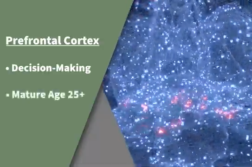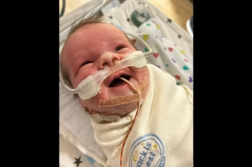DURHAM, N.C. (Ivanhoe Newswire) – More than three million people are living with epilepsy in the U.S. It can develop at any time, but most often, it happens during childhood, causing uncontrollable and unpredictable seizures. It’s one of the most common neurological disorders among children. Medications can help control the seizures and now, there’s new hope for children when the drugs don’t work.
Ela Allam was born a fighter. She had suffered a stroke before she was born.
“We were told Ela’s not gonna walk. She’s not gonna talk,” Alex Allam, Ela’s father, recalls.
But with therapy, Ela defied the odds.
“We saw Ela started to stand up. I started walking with her in the mall,” Alex says.
But then, a few years later, seizures started.
Alex expresses, “To see your kid, seven, eight-years-old, just collapsing on the floor and you don’t know if she’s gonna wake up or not.”
Medication stopped working, and Ela was having three, four, five seizures a day and she was falling behind in school. A final resort was brain surgery. Pediatric neurologist, Associate Professor and Director of the Epilepsy Monitoring Unit at Duke Health, Muhammad Zafar, MD said the hospital believed Ela’s brain had shifted important functions away from the damaged area to other parts of the brain.
“So, her function that was supposed to be carried on by the right hemisphere, moved to the left hemisphere because the injury happened very early in life,” Dr. Zafar explains.
A team at Duke Health performed a hemispherectomy to disconnect the damaged side of her brain from the healthy side.
Dr. Zafar further explains, “We are removing one part of the brain, but for her, fortunately, that’s what saved her life.”
Soon after, Ela started reading, she’s doing well in school, and even learned to swim, and she hasn’t had a single seizure.
“He took the seizures away,” Ela says proudly.
“She’s opening up. It’s like, her brain was locked with a key and somebody just opened it,” Alex exclaims.
Ela is expected to continue to improve and hopefully, with more therapy, as she grows, she will not show any signs of the stroke she had before she was born. Dr. Zafar expects her to be off all seizure medication also.
Contributors to this news report include: Marsha Lewis, Producer; Matt Goldschmidt, Videographer; Roque Correa, Editor.
To receive a free weekly e-mail on medical breakthroughs from Ivanhoe, sign up at: http://www.ivanhoe.com/ftk
MEDICAL BREAKTHROUGHS
RESEARCH SUMMARY
TITLE: UNLOCKING ELA’S BRAIN: STOPPING SEIZURES & SAVING LIVES
REPORT: MB #5386
BACKGROUND: Seizures are sudden, uncontrolled electrical disturbances in the brain that can cause changes in behavior, movements, feelings, and levels of consciousness. They can vary in severity and are a common neurological condition. About 150,000 Americans are diagnosed with epilepsy, which causes seizures, each year. There are two main types of seizures: focal (or partial) and generalized seizures. Inside of focal seizures, there are two subsections: focal onset awareness seizures and focal onset impaired awareness seizures. Inside of generalized seizures, there are several subsections: absence, tonic-clonic, atonic, myoclonic, tonic and clonic seizures.
DIAGNOSING: Signs and symptoms of an oncoming seizure or an actual seizure include, but are not limited to: temporary confusion, a staring spell, uncontrollable jerking movements, loss of consciousness or awareness and/or cognitive or emotional symptoms, like fear, anxiety, or déjà vu. Doctors can diagnose epilepsy and seizures with medical history, physical exams, EEGs, MRIs, CT scans, blood tests and/or PET scans.
(Sources: https://www.healthline.com/health/epilepsy/facts-statistics-infographic#Symptoms)
NEW TECHNOLOGY: Duke Health surgeons saved one little girl from seizures by performing a hemispherectomy. “Epileptologist Muhammad Zafar, MD and Pediatric Neurosurgeon Matthew Vestal, MD recommended Ela Allam undergo a hemispherectomy to disconnect the damaged side of her brain from the healthy side. The procedure would stop seizures without affecting Ela’s function, they said.”
(Source: https://www.dukehealth.org/blog/hemispherectomy-cures-epilepsy-young-girl-now-thriving)
FOR MORE INFORMATION ON THIS REPORT, PLEASE CONTACT:
Stephanie Lopez
If this story or any other Ivanhoe story has impacted your life or prompted you or someone you know to seek or change treatments, please let us know by contacting Marjorie Bekaert Thomas at mthomas@ivanhoe.com




